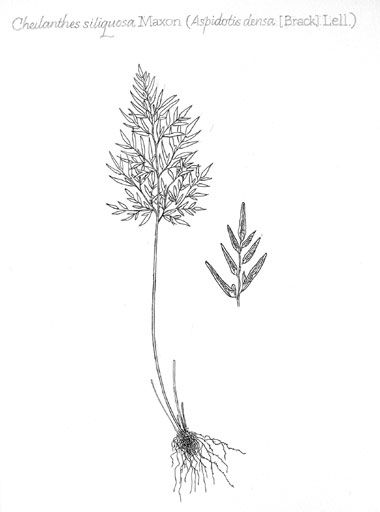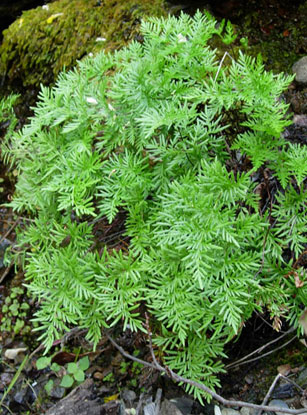|
Hardy Fern Home A. densa resources
All Ferns � Pteridaceae �� Aspidotis
�Other Genera
|
| Aspidotis densa | ||
Indian's dream | ||
|
Etymology
Densa means crowded, or thickly packed.
Description
Rhizome: short-creeping, scales brown to black or often bicolored with dark central stripe.
Frond: 25 cm high , evergreen, somewhat dimorphic, fertile fronds with longer stipes and narrower segments, blade/stipe ratio: 1:3. Stipe: dark reddish brown, with single groove, glabrous, vascular bundles: 1. Blade: 3-pinnate at base, or more, triangular, leathery , glabrous. Pinnae: 5 to 7 pair, composed of very narrow segments; pinnules pointed tips; segments linear, 3-8 mm, midrib prominent below; margins entire; veins obscure, free. Sori: sporangia, submarginal, continuous along length of segments except at apex, indusium: false, inrolled margin, broad, thin, dry, sporangia: dark brown. Culture
Habitat: crevices, rocky outcrops, associated with serpentine, sometimes in chaparral.
Distribution: western North America, British Columbia, western Montana south to Califormia, disjunct in Quebec.
Hardy to -30�C, USDA Zone 4, but given the distribution, the source is likely important.
Distinctive Characteristics
The long, narrow segments, the very long stipe,�and the broad, thin indusium are distinctive.
Synonyms
Onychium densum Brackenridge Cheilanthes siliquosa Maxon Pellaea densa (Brackenridge) Hooker |
|
|

Aspidotis densa. �Illustration by Edgar Paulton, from How to Know the Ferns and Fern Allies, John T. Mickel, � 1979 Wm. C. Brown Co. |

Aspidotis densa. a) taller fertile, shorter (sometimes missing) sterile fronds; b) fertile pinnule. �Illustration by V. Fulford from Ferns and Fern Allies of Canada, William J. Cody and Donald M. Britton, 1989, � Agriculture Canada, used with permission. |
